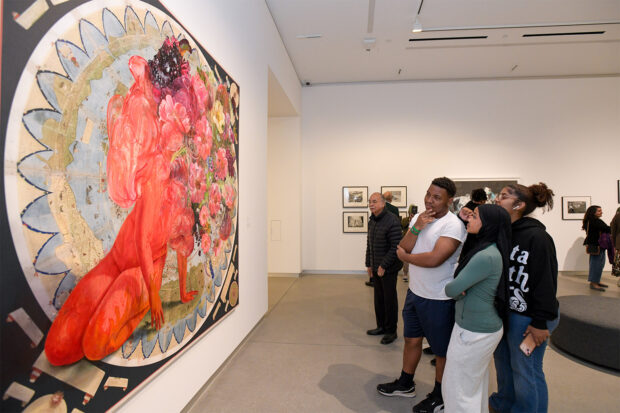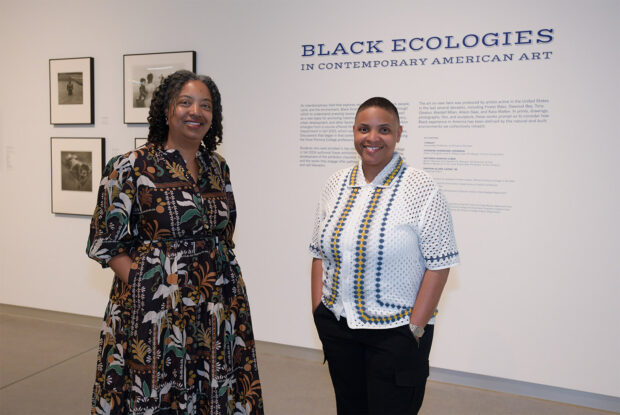As a teaching institution, the Benton Museum of Art strives to cultivate rigorous collaboration with the Pomona community—a philosophy borne out by this spring’s exhibit on “Black Ecologies in Contemporary American Art.”
The show explores relationships among Black people, land and the environment, and features a variety of student contributions curated by J Finley, associate professor of Africana studies; Cherene Sherrard-Johnson, E. Wilson Lyon Professor of the Humanities and chair of the English Department; and Victoria Sancho Lobis, the Sarah Rempel and Herbert S. Rempel ’23 Director of the Benton Museum of Art and associate professor of art history.
As longtime collaborators with the Benton, Finley and Sherrard-Johnson often bring their classes for showings curated specifically for them. Sancho Lobis had the idea in 2023 to create this latest exhibition, inspired by Sherrard-Johnson’s Black Ecologies course.
“[The class] is very much about the body within the environment and the kind of porous boundaries between the two,” says Sherrard-Johnson. “It’s about how the social and political, as well as climate change, impact the health and flourishing of bodies in those spaces.”
This past fall, Finley’s class—Unruly Bodies: Black Womanhood in Popular Culture—explored images of Black women across popular culture, while Sherrard-Johnson’s course—Race, Gender, and the Environment (co-taught with Aimee Bahng, associate professor of gender and women’s studies)—took an intersectional approach to environmental studies.
Students from both classes visited the Benton vaults to help select works for the exhibition that spanned a range of mediums, including photographs, paintings and sculptures.
Reflecting on the experience, Amirah Lockett ’28 says, “I was able to combine my love for art with what I learned from the course and the artworks themselves: appreciating the artists’ different experiences and how they represent those experiences through their work.”

Onlookers admire Firelei Baéz’s Atabey (or change the body that destroys me). Photo credit Carrie Rosema
In addition to being part of the curatorial process, the students created most of the object labels—texts that provide information about the objects on display. Both Finley and Sherrard-Johnson assigned label writing assignments in their classes, and Finley also organized a workshop on label writing by Brittany Webb, a curator at the Pennsylvania Academy of Fine Arts.
“My main objective was to create a narrative that I felt truly conveyed the history, emotions and culture of the Black experience,” says Taylor Parks ’27. Isaiah Dawson ’26 adds, “Co-writing a label for one of the pieces in the exhibit deepened my engagement with the historical themes of the artworks.”
After months of preparation, Sherrard-Johnson says she was “very emotional” seeing the show for the first time. Finley also was appreciative of the opportunity to curate an exhibit with her students.
“One thing I really like to do in my classes is have a creative component,” says Finley. “But I had never done something like involving them in the creation of an exhibition. I always tell the class, ‘We’re not just consuming the knowledge.’ This was an opportunity for us to put that into action.”

